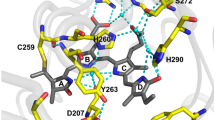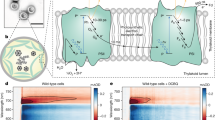Abstract
Wild type green fluorescent protein (GFP) from Aequorea victoria absorbs predominantly at 398 nm. Illumination with UV (254 nm) or visible (390 nm) light transforms this state (GFP398) into one absorbing at 483 nm (GFP483). Here we show that this photoconversion of GFP is a one-photon process that is paralleled by decarboxylation of Glu 222. We propose a mechanism in which decarboxylation is due to electron transfer between the γ-carboxylate of Glu 222 and the p-hydroxybenzylidene-imidazolidinone chromophore of GFP, followed by reverse transfer of an electron and a proton to the remaining carbon side chain atom of Glu 222. Oxidative decarboxylation of a γ-carboxylate represents a new type of posttranslational modification that may also occur in enzymes with high-potential reaction intermediates.
This is a preview of subscription content, access via your institution
Access options
Subscribe to this journal
Receive 12 print issues and online access
$189.00 per year
only $15.75 per issue
Buy this article
- Purchase on Springer Link
- Instant access to full article PDF
Prices may be subject to local taxes which are calculated during checkout




Similar content being viewed by others
References
Shimomura, O. FEBS Lett. 104, 220–222 (1979).
Yang, F., Moss, L.G. & Phillips, G.N. Jr. Nature Biotech. 14, 1246–1251 (1996).
Ormö, M. et al. Science 273, 1392–1395 (1996).
Tsien, R.Y. Annu. Rev. Biochem. 67, 509–544 (1998).
Heim, R., Prasher, D.C. & Tsien, R.Y. Proc. Natl. Acad. Sci. USA 91, 12501–12504 (1994).
Brejc, K. et al. Proc. Natl. Acad. Sci. USA 94, 2306–2311 (1997).
Palm, G.J. et al. Nature Struct. Biol. 4, 361–365 (1997).
Heim, R., Cubitt, A.B. & Tsien, R.Y. Nature 373, 663–664 (1995).
Chattoraj, M., King, B.A., Bublitz, G.U. & Boxer, S.G. Proc. Natl. Acad. Sci. USA 93, 8362–8367 (1996).
Bubliz, G., King, B.A. & Boxer, S.G. J. Am. Chem. Soc. 120, 9370–9371 (1998).
Youvan, D.C. & Michel-Beyerle, M.E. Nature Biotech. 14, 1219–1220 (1996).
Chalfie, M., Tu, Y., Euskirchen, G., Ward, W.W. & Prasher, D.C. Science 263, 802–805 (1994).
Cubitt, A.B., et al. Trends. Biochem. Sci. 20, 448–455 (1995).
van Thor, J.J., Pierik, A.J., Nugteren-Roodzant, I., Xie, A. & Hellingwerf, K.J. Biochemistry 37, 16915–16921 (1998).
Ehrig, T., O'Kane, D.J. & Prendergast, F.G. FEBS Lett. 367, 163–166 (1995).
Striker, G., Subramaniam, V., Seidel, C.A.M. & Volkmer, A. J. Phys. Chem. B. 103, 8612–8617 (1999).
Seebacher, C., Deeg, F.W. & Brauchle, C. J. Phys. Chem. B. 103, 7728–7732 (1999).
Creemers, T.M., Lock, A.J., Subramaniam, V., Jovin, T.M. & Volker, S. Nature Struct. Biol. 6, 557–560 (1999).
Elsliger, M.A., Wachter, R.M., Hanson, G.T., Kallio, K. & Remington, S.J. Biochemistry 38, 5296–5301 (1999).
Burmeister, W.P. Acta Crystallogr. D. 56, 328–341 (2000).
Ward, W.W., Prentice, H.J., Roth, A.F., Cody, C.W. & Reeves, S.C. Photochem. Photobiol. 35, 803–808 (1982).
Kolbe, H. Ann. Chem. Pharm. 69, 257–294 (1849).
Anderson, J.M. & Kochi, J.K. J. Am. Chem. Soc. 92, 2450–2460 (1970).
Crameri, A., Whitehorn, E.A., Tate, E. & Stemmer, W.P. Nature Biotech. 14, 315–319 (1996).
Leslie, A.G.W. In Crystallographic computing (eds Moras, D., Podjarni, A.D. & Thierry, J.C.) 50–61 (Oxford University Press, Oxford; 1991).
Collaborative Computational Project, Number 4. Acta Crystallogr. D 50, 760–763 (1994).
Acknowledgements
We acknowledge E. Garman for helping establish the extent of X-ray induced structural damage and T. Davies for help with crystallographic computing. We thank A. Watts for help with ESR measurements, and C. Valance, R. Wilmouth and R. Aplin for access to their facilities. J.J.v.T. acknowledges financial support from the European Molecular Biology Organization and the Human Frontier Science Program Organization.
Author information
Authors and Affiliations
Corresponding author
Rights and permissions
About this article
Cite this article
van Thor, J., Gensch, T., Hellingwerf, K. et al. Phototransformation of green fluorescent protein with UV and visible light leads to decarboxylation of glutamate 222. Nat Struct Mol Biol 9, 37–41 (2002). https://doi.org/10.1038/nsb739
Received:
Accepted:
Published:
Issue Date:
DOI: https://doi.org/10.1038/nsb739
This article is cited by
-
Chromophore Renewal and Fluorogen-Binding Tags: A Match Made to Last
Scientific Reports (2017)
-
Photophysics of EGFP (E222H) Mutant, with Comparisons to Model Chromophores: Excited State pK’s, Progressions, Quenching and Exciton Interaction
Journal of Fluorescence (2017)
-
Establishing super-resolution imaging for proteins in diatom biosilica
Scientific Reports (2016)
-
Phototransformable fluorescent proteins: which one for which application?
Histochemistry and Cell Biology (2014)
-
Super-resolution localization microscopy with photoactivatable fluorescent marker proteins
Protoplasma (2014)



